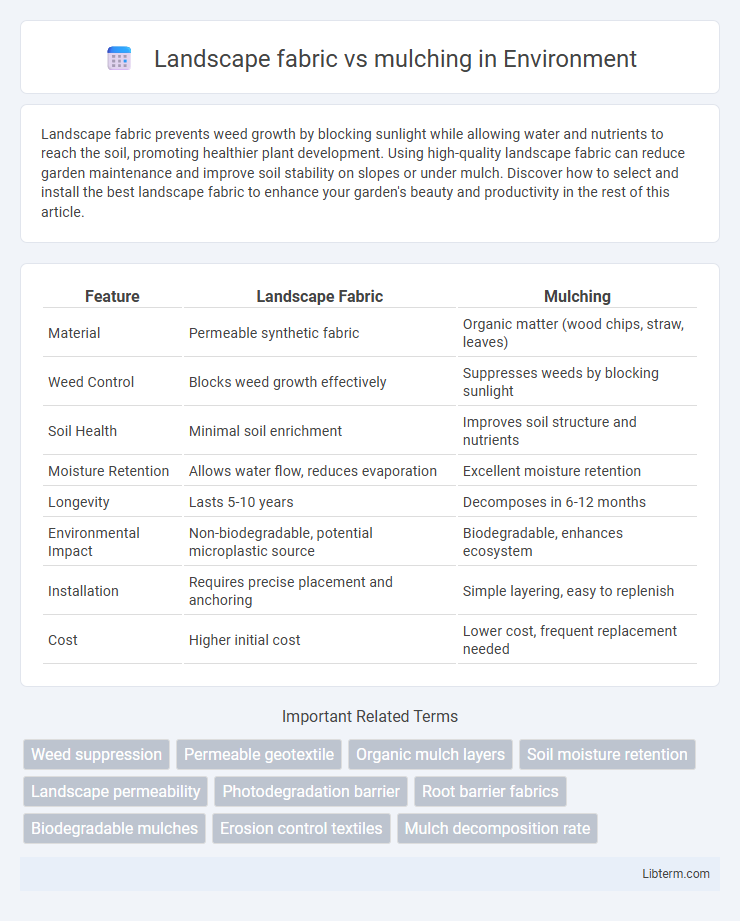Landscape fabric prevents weed growth by blocking sunlight while allowing water and nutrients to reach the soil, promoting healthier plant development. Using high-quality landscape fabric can reduce garden maintenance and improve soil stability on slopes or under mulch. Discover how to select and install the best landscape fabric to enhance your garden's beauty and productivity in the rest of this article.
Table of Comparison
| Feature | Landscape Fabric | Mulching |
|---|---|---|
| Material | Permeable synthetic fabric | Organic matter (wood chips, straw, leaves) |
| Weed Control | Blocks weed growth effectively | Suppresses weeds by blocking sunlight |
| Soil Health | Minimal soil enrichment | Improves soil structure and nutrients |
| Moisture Retention | Allows water flow, reduces evaporation | Excellent moisture retention |
| Longevity | Lasts 5-10 years | Decomposes in 6-12 months |
| Environmental Impact | Non-biodegradable, potential microplastic source | Biodegradable, enhances ecosystem |
| Installation | Requires precise placement and anchoring | Simple layering, easy to replenish |
| Cost | Higher initial cost | Lower cost, frequent replacement needed |
Introduction to Landscape Fabric and Mulching
Landscape fabric is a woven or non-woven polypropylene material designed to suppress weed growth while allowing water and air to penetrate the soil. Mulching involves applying organic or inorganic materials like wood chips, straw, or gravel as a protective soil cover to retain moisture and regulate temperature. Both methods improve soil health and plant growth but differ in application, longevity, and soil interaction.
What is Landscape Fabric?
Landscape fabric is a permeable textile designed to suppress weed growth while allowing water and nutrients to pass through to the soil. Made from woven or non-woven polypropylene or polyester, it creates a physical barrier that reduces soil erosion and moisture evaporation. Often used under mulch or gravel, landscape fabric enhances garden bed maintenance by minimizing weed competition and promoting healthier plant growth.
What is Mulching?
Mulching involves covering the soil surface with organic or inorganic materials such as wood chips, straw, or compost to retain moisture, suppress weeds, and regulate soil temperature. Unlike landscape fabric, mulching decomposes over time, enriching the soil with nutrients and improving its structure. Proper mulching promotes healthy plant growth by maintaining optimal soil conditions and reducing erosion.
Pros and Cons of Landscape Fabric
Landscape fabric offers effective weed control by blocking sunlight and reducing soil erosion, making it ideal for long-term garden maintenance. However, it can impede water and nutrient flow to plant roots, potentially affecting plant health, and may require periodic removal and replacement as debris accumulates on its surface. Unlike organic mulch, it does not improve soil fertility, which can limit soil quality improvement over time.
Pros and Cons of Mulching
Mulching enhances soil moisture retention, suppresses weed growth, and improves soil fertility through organic matter decomposition, promoting healthier plant growth. However, mulch requires regular replenishment, can attract pests if not managed properly, and may harbor diseases if applied incorrectly. Unlike landscape fabric, mulch naturally breaks down over time, necessitating ongoing maintenance but providing essential nutrients to the soil.
Weed Control: Landscape Fabric vs Mulch
Landscape fabric provides a durable barrier that effectively blocks weed growth by preventing sunlight from reaching the soil, making it ideal for long-term weed control in garden beds and pathways. Mulch, while also suppressing weeds by limiting light and maintaining soil moisture, decomposes over time and requires regular replenishment to maintain its weed-preventing properties. Combining landscape fabric with a layer of mulch enhances weed control effectiveness by leveraging fabric's durability and mulch's organic benefits.
Soil Health and Moisture Retention Comparison
Landscape fabric enhances soil moisture retention by preventing weed growth and reducing water evaporation, but it can limit organic matter integration into the soil. Mulching improves soil health by adding organic nutrients as it decomposes and promotes beneficial microbial activity. While both methods conserve moisture, mulching offers superior long-term soil fertility benefits compared to landscape fabric.
Installation and Maintenance Differences
Landscape fabric installation involves laying a permeable material beneath mulch to suppress weeds while allowing water and air flow, requiring precise cutting around plants for optimal effectiveness. Mulching involves spreading organic or inorganic material directly on the soil surface, which is simpler to install but requires regular replenishing as it decomposes or disperses. Maintenance of landscape fabric includes periodically checking for fabric tears and ensuring mulch remains adequately layered, whereas mulching demands frequent topping up and monitoring for mold, pests, or compaction.
Cost Analysis: Which is More Economical?
Landscape fabric typically incurs higher upfront costs, ranging from $0.10 to $0.50 per square foot, but offers long-term savings by reducing weed growth and maintenance expenses. Mulching costs vary depending on material, averaging $15 to $75 per cubic yard, with more frequent replacement needed every one to two years. Overall, mulching tends to be more economical for short-term projects, while landscape fabric provides better cost efficiency for long-term landscaping maintenance.
Best Applications: Choosing Between Fabric and Mulch
Landscape fabric excels in weed control for pathways and garden beds prone to erosion, allowing water infiltration while minimizing soil disruption. Mulching is ideal for improving soil moisture retention, enriching organic matter, and enhancing aesthetics in flower beds and vegetable gardens. Combining both can optimize weed suppression and soil health in high-maintenance landscapes.
Landscape fabric Infographic

 libterm.com
libterm.com